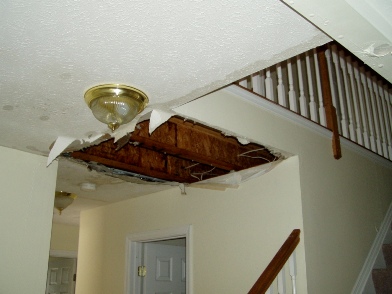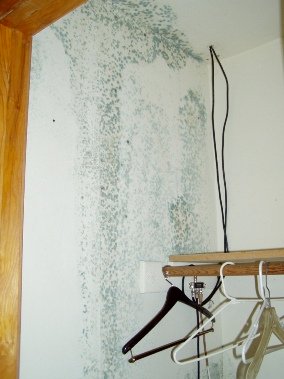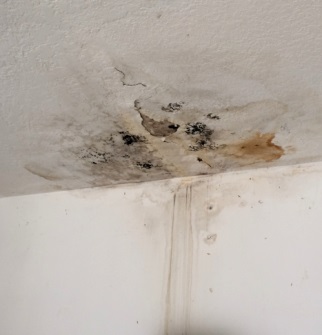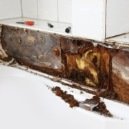Find a pre-screened local mold removal specialist Free Estimate
Find a Mold Specialist Now
Click or Call, Toll-Free 24/7
Ceiling Water Leak
A ceiling water leak is often, but not always, caused by a leak in the roof of a house. There are other events that could lead to a leak above the ceiling. These other events could include plumbing problems, an uncapped chimney stack, a leaky skylight, a leak around a window, missing siding or even a masonry leak.
A water leak in the ceiling is a problem for a number of reasons. By the time you realize you have a leak, you can have serious damage not only to your ceiling, but to your roof, your walls and your flooring. Damage to your roof can be hazardous. It can also be quite expensive to repair.
In addition, a great deal of mold can grow in your attic or in the space between your ceiling and your roof, and exposure to this sort of household mold has been linked to numerous health problems, including respiratory disorders and infections, asthma attacks, pneumonia, chronic sinusitis, headaches and migraines, chronic sore throats, rashes, hives, allergic reactions, depression, fatigue, digestive problems and more. Once mold begins to grow as a result of a water leak, you may end up needing to remove and replace insulation, drywall, ceiling tiles and other materials because they are anywhere from difficult to impossible to clean.
How to Find a Water Leak in Your Roof
It can be difficult to find a leak in your roof. Often, a leak doesn’t become apparent right away. You may not notice a leak until it’s gotten pretty bad. For that reason, it’s recommended that you inspect your roof periodically and address any signs of damage as soon as you notice it. Don’t put it off, because by the time you notice it, the problem may already be pretty serious.
Signs of a leaky roof to watch for include:
- Discolored spots on the ceiling
- Peeling paint or rotting wood around skylights
- Water stains or mold or mildew around your chimney
- Finding shingles or other bits of debris from the roof in your yard
- Buckling or curling roofing shingles, or loss of granulation
- A musty smell, especially in your attic (this is a sign of mold growth, which frequently occurs when your roof has been leaking)
- Damaged or cracked flashing on your roof
- Chimney issues such as damaged bricks, cracked joints or damaged flashing
- Formation of ice dams
You may notice water dripping from the ceiling in severe cases, especially during a hard rain or when a heavy snow is melting, but often that doesn’t happen until the damage is significant. It’s better if you can catch the problem earlier.
Other Ceiling Water Leaks
Many times water leaks are a result of a broken water line on the second floor or in the attic. We’ve seen HVAC units located in attics and on second floors. We have also seen water supply lines from water softeners that are run through attic spaces. In both these cases a slow leak or a waterline rupture can cause water-damaged ceilings. If there is a second floor, usually there will be at least one bathroom located on it. Newer homes even have laundry rooms on the second floor. Plumbing lines break, toilets overflow, the caulked seams around tubs and showers begin to separate as they age. There are so many things that can go wrong above a ceiling that there are too many to mention.
 Water leak from second floor
Water leak from second floorSafety Issues
When checking for the source of a ceiling water leak, roofing experts and medical professionals alike recommend homeowners not to climb up on their roof to look for signs of trouble. Falls from roofs are a very common cause of injury and can even be deadly. There are even cases where roofing professionals and insurance adjusters have fallen off of roofs and been killed. Instead, homeowners should inspect their roofs as best as they can from the ground, as well as inspecting the attic of the home and keeping an eye out for the signs of a leaky roof listed above.
Any leak that happens slowly over time can lead to a mold problem. When the leak is concealed behind a ceiling it can be some time before the leak becomes apparent. Under the right conditions, mold can begin to grow in as little as 24 hours. That dark spot on your ceiling may be the result of more than just a ceiling water leak.
When you have a ceiling water leak there is always the chance that the ceiling may fall due to the weight of the water and the loss of structural integrity in the ceiling material. It may not fall right away, but as the leak continues, the overall weight can add up. Use extreme care when entering a room whose ceiling has been affected by water from above. Wet insulation can also be present, especially in an attic, and that too can add to the weight on ceiling material.
Call a professional if you think your roof needs to be inspected. Professional roofers and other contractors that regularly climb ladders and work on rooftops have safety training as well as the appropriate safety gear, and they can inspect the top of your roof safely.
If You Have a Ceiling Water Leak
If you have, or suspect you have, a leak in your ceiling or roof, or if you think you have mold growing in your attic or above your ceiling, we suggest calling in a mold remediation professional that can inspect your home for water damage and mold. They will be able to find the source of the leak and then advise you about the repairs needed, including the safety measures that should be taken while making the repairs. Mold remediation professionals have equipment to dry out damp attics or other areas quickly in order to prevent additional water damage and mold growth.
Most mold remediation professionals offer free inspections and consultations in your home, so you have nothing to lose. Even if you decide to handle the mold removal or other repairs yourself, you can benefit from some expert advice. To find experienced professionals offering free inspections and consultations in your area, just follow the link provided.
Free Home Inspection By A Mold Removal Specialist
Search This Website
 Mold in closet from leak
Mold in closet from leakRecent Articles
-
See Our 5 Recommended Mold Removal Companies in Covington, KY
Apr 16, 25 12:59 PM
-
See Our 5 Recommended Mold Removal Companies in Wheaton, IL
Jun 20, 24 10:33 AM
-
See Our 5 Recommended Mold Removal Companies in Aberdeen, SD
Oct 08, 21 04:05 PM





